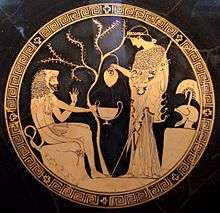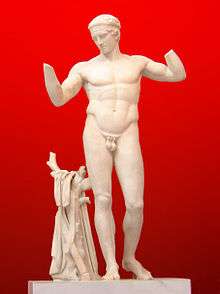Ancient Greek art
| Part of a series on the |
| History of Greek art |
|---|
.jpeg) |
| Greek Bronze Age |
| Ancient Greece |
| Medieval Greece |
| Post-Byzantine Greece |
| Modern Greece |
| Ancient art history |
|---|
| Middle East |
| Asia |
| European prehistory |
| Classical art |
The arts of ancient Greece have considerable influence on the culture of many countries all over the world, particularly in the areas of sculpture and architecture. In the West, the art of the Roman Empire was largely derived from Greek models. In the East, Alexander the Great's conquests initiated several centuries of exchange between Greek, Central Asian and Indian cultures, resulting in Greco-Buddhist art, with ramifications as far as Japan. Following the Renaissance in Europe, the humanist aesthetic and the high technical standards of Greek art inspired generations of European artists. Well into the 19th century, the classical tradition derived from Greece dominated the art of the western world.
The art of Ancient Greece is usually divided stylistically into four periods: the Geometric, Archaic, Classical, and Hellenistic. The Geometric age is usually dated from about 1000 BC, although in reality little is known about art in Greece during the preceding 200 years (traditionally known as the Greek Dark Ages), the period of the 7th century BC witnessed the slow development of the Archaic style as exemplified by the black-figure style of vase painting. The onset of the Persian Wars (480 BC to 448 BC) is usually taken as the dividing line between the Archaic and the Classical periods, and the reign of Alexander the Great (336 BC to 323 BC) is taken as separating the Classical from the Hellenistic periods.
In reality, there was no sharp transition from one period to another. Forms of art developed at different speeds in different parts of the Greek world, and as in any age some artists worked in more innovative styles than others. Strong local traditions, conservative in character, and the requirements of local cults, enable historians to locate the origins even of displaced works of art.
Pottery
The Ancient Greeks made pottery for everyday use, not for display; the trophies won at games, such as the Panathenaic Amphorae (wine decanters), are the exception. Most surviving pottery consists of drinking vessels such as amphorae, kraters (bowls for mixing wine and water), hydria (water jars), libation bowls, jugs and cups. Painted funeral urns have also been found. Miniatures were also produced in large numbers, mainly for use as offerings at temples. In the Hellenistic period a wider range of pottery was produced, but most of it is of little artistic importance.
At the end of the Geometric phase, the Orientalizing phase of vase painting saw the abstract geometric designs replaced by the more rounded, realistic forms of Eastern motifs, such as the lotus, palmette, lion, and sphinx. Ornaments increased in amount and intricacy.
In earlier periods even quite small Greek cities produced pottery for their own locale. These varied widely in style and standards. Distinctive pottery that ranks as art was produced on some of the Aegean islands, in Crete, and in the wealthy Greek colonies of southern Italy and Sicily. By the later Archaic and early Classical period, however, the two great commercial powers, Corinth and Athens, came to dominate. Their pottery was exported all over the Greek world, driving out the local varieties. Pots from Corinth and Athens are found as far afield as Spain and Ukraine, and are so common in Italy that they were first collected in the 18th-century as "Etruscan vases". Many of these pots are mass-produced products of low quality. In fact, by the 5th century BC, pottery had become an industry and pottery painting ceased to be an important art form.
The history of Ancient Greek pottery is divided stylistically into five periods:
- the Protogeometric from about 1050 BC
- the Geometric from about 900 BC
- the Late Geometric or Archaic from about 750 BC
- the Black Figure from the early 7th century BC
- and the Red Figure from about 530 BC
The range of colours which could be used on pots was restricted by the technology of firing: black, white, red, and yellow were the most common. In the three earlier periods, the pots were left their natural light colour, and were decorated with slip that turned black in the kiln.
The fully mature black-figure technique, with added red and white details and incising for outlines and details, originated in Corinth during the early 7th century BC and was introduced into Attica about a generation later; it flourished until the end of the 6th century BC. The red-figure technique, invented in about 530 BC, reversed this tradition, with the pots being painted black and the figures painted in red. Red-figure vases slowly replaced the black-figure style. Sometimes larger vessels were engraved as well as painted.
During the Protogeometric and Geometric periods, Greek pottery was decorated with abstract designs. In later periods, as the aesthetic shifted and the technical proficiency of potters improved, decorations took the form of human figures, usually representing the gods or the heroes of Greek history and mythology. Battle and hunting scenes were also popular, since they allowed the depiction of the horse, which the Greeks held in high esteem. In later periods erotic themes, both heterosexual and male homosexual, became common.
Greek pottery is frequently signed, sometimes by the potter or the master of the pottery, but only occasionally by the painter. Hundreds of painters are, however, identifiable by their artistic personalities: where their signatures haven't survived they are named for their subject choices, as "the Achilles Painter", by the potter they worked for, such as the Late Archaic "Kleophrades Painter", or even by their modern locations, such as the Late Archaic "Berlin Painter".
-

Late Geometric pyxis, British Museum
-

Corinthian orientalising jug, c. 620 BC, Antikensammlungen Munich
-

Black-figure olpe (wine vessel) by the Amasis Painter, depicting Herakles and Athena, c. 540 BC, Louvre
-

White-ground lekythos with a scene of mourning by the Reed Painter, c. 420-410 BC, British Museum
-
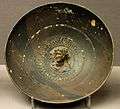
Hellenistic relief bowl with the head of a maenad, 2nd century BC (?), British Museum
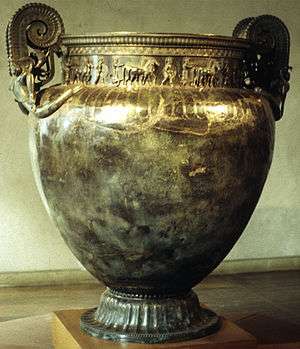
Metal vessels
Especially during the Geometric and Archaic phases, the production of large metal vessels was an important expression of Greek creativity, and an important stage in the development of bronzeworking techniques, such as casting and repousse hammering. Early sanctuaries, especially Olympia, yielded many hundreds of such vessels, deposited as votives. During the orientalising period, such tripods were frequently decorated with figural protomes, in the shape of griffins, sphinxes and other fantastic creatures. Although large metal vessels became less important during the Archaic and Classical periods, their production did not cease entirely. The Vix crater is a famous example dating to c. 530 BC.
Figurines
Terracotta figurines

Clay is a material frequently used for the making of votive statuettes or idols, since well before Minoan civilization until the Hellenistic era and beyond. During the 8th century BC, in Boeotia, one finds manufactured "Bell Idols", female statuettes with mobile legs: the head, small compared to the remainder of the body, is perched at the end of a long neck, while the body is very full, in the shape of bell. At the beginning of 8th century BC, tombs known as "hero's" receive hundreds, even thousands of small figurines, with rudimentary figuration, generally representing characters with the raised arms, i.e. gods in apotheosis.
In later periods the terracotta figurines lose their religious nature, representing from then on characters from everyday life. With 4th and 3rd centuries BC, a type known as Tanagra figurines shows a refined art. Tanagra figurines often preserve extensive traces of surface paint. At the same time, cities like Alexandria, Smyrna or Tarsus produced an abundance of grotesque figurines, representing individuals with deformed members, eyes bulging and contorting themselves. Such figurines were also made from bronze.
For painted architectural terracottas, see below, under "painting"...
Metal figurines

Figurines made of metal, primarily bronze, are an extremely common find at early Greek sanctuaries like Olympia, where thousands of such objects, mostly depicting animals, have been found. They are usually produced in the lost wax technique and can be considered the initials stage in the development of Greek bronze sculpture. The most common motifs during the Geometric period were horses and deer, but dogs, cattle and other animals are also depicted. Human figures occur occasionally. The production of small metal votives continued throughout Greek antiquity. In the Classical and Hellenistic periods, more elaborate bronze statuettes, closely connected with monumental sculpture, also became common.
Monumental sculpture
Those who practiced the visual arts, including sculpture, were held in low regard in ancient Greece, viewed as mere manual laborers. Plutarch (Life of Pericles, II) said "we admire the work of art but despise the maker of it"; this was a common view in the ancient world. Ancient Greek art today is often categorised in three epochs: "Archaic", "Classical" and "Hellenistic".
Materials, forms
Ancient Greek sculptures were mostly made of two types of material. Stone, especially marble or other high-quality limestones was used most frequently and carved by hand with metal tools. Stone sculptures could be free-standing fully carved in the round (statues), or only partially carved reliefs still attached to a background plaque, for example in architectural friezes or grave stelai.
Bronze statues were of higher status, but have survived in far smaller numbers, due to the reusability of metals. They were usually made in the lost wax technique. Chryselephantine, or gold-and-ivory, statues often adorned temples and were regarded as the highest form of sculpture, but virtually none have survived.
Terracotta was occasionally employed, for large statuary. Few examples of this survived, at least partially due to the fragility of such statues. The best known exception to this is a statue of Zeus carrying Ganymede found at Olympia, executed around 470 BC. In this case, the terracotta is painted.
Archaic

Inspired by the monumental stone sculpture of Egypt and Mesopotamia, during the Archaic period the Greeks began again to carve in stone. Free-standing figures share the solidity and frontal stance characteristic of Eastern models, but their forms are more dynamic than those of Egyptian sculpture, as for example the Lady of Auxerre and Torso of Hera (Early Archaic period, c. 660-580 BC, both in the Louvre, Paris). After about 575 BC, figures, such as these, both male and female, wore the so-called archaic smile. This expression, which has no specific appropriateness to the person or situation depicted, may have been a device to give the figures a distinctive human characteristic.
Three types of figures prevailed—the standing nude youth (kouros), the standing draped girl (kore), and the seated woman. All emphasize and generalize the essential features of the human figure and show an increasingly accurate comprehension of human anatomy. The youths were either sepulchral or votive statues. Examples are Apollo (Metropolitan Museum of Art, New York), an early work; the Strangford Apollo from Anafi (British Museum, London), a much later work; and the Anavyssos Kouros (National Archaeological Museum of Athens). More of the musculature and skeletal structure is visible in this statue than in earlier works. The standing, draped girls have a wide range of expression, as in the sculptures in the Acropolis Museum of Athens. Their drapery is carved and painted with the delicacy and meticulousness common in the details of sculpture of this period.
The Greeks thus decided very early on that the human form was the most important subject for artistic endeavour. Seeing their gods as having human form, there was no distinction between the sacred and the secular in art—the human body was both secular and sacred. A male nude could just as easily be Apollo or Heracles as that year's Olympic boxing champion. In the Archaic Period the most important sculptural form was the kouros (plural kouroi), the standing male nude (See for example Biton and Kleobis). The kore (plural korai), or standing clothed female figure, was also common, but since Greek society did not permit the public display of female nudity until the 4th century BC, the kore is considered to be of less importance in the development of sculpture.
As with pottery, the Greeks did not produce sculpture merely for artistic display. Statues were commissioned either by aristocratic individuals or by the state, and used for public memorials, as offerings to temples, oracles and sanctuaries (as is frequently shown by inscriptions on the statues), or as markers for graves. Statues in the Archaic period were not all intended to represent specific individuals. They were depictions of an ideal—beauty, piety, honor or sacrifice. These were always depictions of young men, ranging in age from adolescence to early maturity, even when placed on the graves of (presumably) elderly citizens. Kouroi were all stylistically similar. Graduations in the social stature of the person commissioning the statue were indicated by size rather than artistic innovations.
-
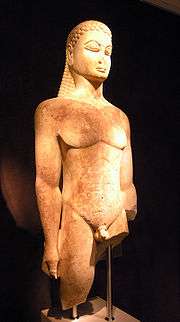
Dipylon Kouros, c. 600 BC, Athens, Kerameikos Museum
-

The Moschophoros or calf-bearer, c. 570 BC, Athens, Acropolis Museum
-
Peplos Kore, c. 530 BC, Athens, Acropolis Museum
-

Frieze of the Siphnian Treasury, Delphi, depicting a Gigantomachy, c. 525 BC, Delphi Archaeological Museum
Classical

In the Classical period there was a revolution in Greek statuary, usually associated with the introduction of democracy and the end of the aristocratic culture associated with the kouroi. The Classical period saw changes in the style and function of sculpture. Poses became more naturalistic (see the Charioteer of Delphi for an example of the transition to more naturalistic sculpture), and the technical skill of Greek sculptors in depicting the human form in a variety of poses greatly increased. From about 500 BC statues began to depict real people. The statues of Harmodius and Aristogeiton set up in Athens to mark the overthrow of the tyranny were said to be the first public monuments to actual people.
At the same time sculpture and statues were put to wider uses. The great temples of the Classical era such as the Parthenon in Athens, and the Temple of Zeus at Olympia, required relief sculpture for decorative friezes, and sculpture in the round to fill the triangular fields of the pediments. The difficult aesthetic and technical challenge stimulated much in the way of sculptural innovation. Unfortunately these works survive only in fragments, the most famous of which are the Parthenon Marbles, half of which are in the British Museum.

Funeral statuary evolved during this period from the rigid and impersonal kouros of the Archaic period to the highly personal family groups of the Classical period. These monuments are commonly found in the suburbs of Athens, which in ancient times were cemeteries on the outskirts of the city. Although some of them depict "ideal" types—the mourning mother, the dutiful son—they increasingly depicted real people, typically showing the departed taking his dignified leave from his family. They are among the most intimate and affecting remains of the Ancient Greeks.
In the Classical period for the first time we know the names of individual sculptors. Phidias oversaw the design and building of the Parthenon. Praxiteles made the female nude respectable for the first time in the Late Classical period (mid-4th century): his Aphrodite of Knidos, which survives in copies, was said by Pliny to be the greatest statue in the world.
The greatest works of the Classical period, the Statue of Zeus at Olympia and the Statue of Athena Parthenos (both chryselephantine and executed by Phidias or under his direction), are lost, although smaller copies (in other materials) and good descriptions of both still exist. Their size and magnificence prompted emperors to seize them in the Byzantine period, and both were removed to Constantinople, where they were later destroyed in fire
-

So-called Venus Braschi by Praxiteles, type of the Knidian Aphrodite, Munich Glyptothek
-
The Marathon Youth, 4th-century BC bronze statue, possibly by Praxiteles, National Archaeological Museum, Athens
-

Hermes, possibly by Lysippos, National Archaeological Museum, Athens
Hellenistic
The transition from the Classical to the Hellenistic period occurred during the 4th century BC. Following the conquests of Alexander the Great (336 BC to 323 BC), Greek culture spread as far as India, as revealed by the excavations of Ai-Khanoum in eastern Afghanistan, and the civilization of the Greco-Bactrians and the Indo-Greeks. Greco-Buddhist art represented a syncretism between Greek art and the visual expression of Buddhism.
Thus Greek art became more diverse and more influenced by the cultures of the peoples drawn into the Greek orbit. In the view of some art historians, it also declined in quality and originality; this, however, is a judgement which artists and art-lovers of the time would not have shared. Indeed, many sculptures previously considered as classical masterpieces have turned out to be of the Hellenistic age. Also, the technical ability of the Hellenistic sculptors are clearly in evidence in such major works as the Winged Victory of Samothrace, and the Pergamon Altar. New centres of Greek culture, particularly in sculpture, developed in Alexandria, Antioch, Pergamum, and other cities. By the 2nd century the rising power of Rome had also absorbed much of the Greek tradition—and an increasing proportion of its products as well.
During this period sculpture became more naturalistic. Common people, women, children, animals and domestic scenes became acceptable subjects for sculpture, which was commissioned by wealthy families for the adornment of their homes and gardens. Realistic portraits of men and women of all ages were produced, and sculptors no longer felt obliged to depict people as ideals of beauty or physical perfection. At the same time, the new Hellenistic cities springing up all over Egypt, Syria, and Anatolia required statues depicting the gods and heroes of Greece for their temples and public places. This made sculpture, like pottery, an industry, with the consequent standardisation and some lowering of quality. For these reasons many more Hellenistic statues have survived than is the case with the Classical period.
Some of the best known Hellenistic sculptures are the Winged Victory of Samothrace (2nd or 1st century BC), the statue of Aphrodite from the island of Melos known as the Venus de Milo (mid-2nd century BC), the Dying Gaul (about 230 BC), and the monumental group Laocoön and His Sons (late 1st century BC). All these statues depict Classical themes, but their treatment is far more sensuous and emotional than the austere taste of the Classical period would have allowed or its technical skills permitted.
Discoveries made since the end of the 19th century surrounding the (now submerged) ancient Egyptian city of Heracleum include a 4th-century BC, unusually sensual, detailed and feministic (as opposed to deified) depiction of Isis, marking a combination of Egyptian and Hellenistic forms beginning around the time of Egypt's conquest by Alexander the Great.
Hellenistic sculpture was also marked by an increase in scale, which culminated in the Colossus of Rhodes (late 3rd century), which was the same size as the Statue of Liberty. The combined effect of earthquakes and looting have destroyed this as well as other very large works of this period.
-

The Winged Victory of Samothrace (Hellenistic), The Louvre, Paris
-

Laocoön and His Sons (Late Hellenistic), Vatican Museum
-

Late Hellenistic bronze statue of a mounted jockey, National Archaeological Museum, Athens
Architecture

Architecture (building executed to an aesthetically considered design) was extinct in Greece from the end of the Mycenaean period (about 1200 BC) until the 7th century, when urban life and prosperity recovered to a point where public building could be undertaken. But since most Greek buildings in the Archaic and Early Classical periods were made of wood or mud-brick, nothing remains of them except a few ground-plans, and there are almost no written sources on early architecture or descriptions of buildings. Most of our knowledge of Greek architecture comes from the few surviving buildings of the Classical, Hellenistic and Roman periods (since Roman architecture heavily copied Greek), and from late written sources such as Vitruvius (1st century AD). This means that there is a strong bias towards temples, the only buildings which survive in any number.
The standard format of Greek public buildings is well known from surviving examples such as the Parthenon, and even more so from Roman buildings built partly on the Greek model, such as the Pantheon in Rome. The building was usually either a cube or a rectangle made from limestone, of which Greece has an abundance, and which was cut into large blocks and dressed. Marble was an expensive building material in Greece: high quality marble came only from Mt Pentelus in Attica and from a few islands such as Paros, and its transportation in large blocks was difficult. It was used mainly for sculptural decoration, not structurally, except in the very grandest buildings of the Classical period such as the Parthenon.
There were two main styles (or "orders") of Greek architecture, the Doric and the Ionic. These names were used by the Greeks themselves, and reflected their belief that the styles descended from the Dorian and Ionian Greeks of the Dark Ages, but this is unlikely to be true. The Doric style was used in mainland Greece and spread from there to the Greek colonies in Italy. The Ionic style was used in the cities of Ionia (now the west coast of Turkey) and some of the Aegean islands. The Doric style was more formal and austere, the Ionic more relaxed and decorative. The more ornate Corinthian style was a later development of the Ionic. These styles are best known through the three orders of column capitals, but there are differences in most points of design and decoration between the orders. See the separate article on Classical orders.
Most of the best known surviving Greek buildings, such as the Parthenon and the Temple of Hephaestus in Athens, are Doric. The Erechtheum, next to the Parthenon, however, is Ionic. The Ionic order became dominant in the Hellenistic period, since its more decorative style suited the aesthetic of the period better than the more restrained Doric. Some of the best surviving Hellenistic buildings, such as the Library of Celsus, can be seen in Turkey, at cities such as Ephesus and Pergamum. But in the greatest of Hellenistic cities, Alexandria in Egypt, almost nothing survives.
-

The Erechtheion on the Acropolis of Athens, late 5th century BC
-

The Temple of Hephaistos at Athens, late 5th century BC
-

The theatre of Epidauros, 4th century BC
-

The walls of Messene: Hellenistic defensive architecture
Coin design
Coins were invented in Lydia in the 7th century BC, but they were first extensively used by the Greeks, and the Greeks set the canon of coin design which has been followed ever since. Coin design today still recognisably follows patterns descended from Ancient Greece. The Greeks did not see coin design as a major art form, although some, especially outside Greece itself, among the Central Asian kingdoms and in Sicilian cities keen to promote themselves, were expensively designed by leading goldsmiths, but the durability and abundance of coins have made them one of the most important sources of knowledge about Greek aesthetics. Greek coins are, incidentally, the only art form from the ancient Greek world which can still be bought and owned by private collectors of modest means.
Greek designers began the practice of putting a profile portrait on the obverse of coins. This was initially a symbolic portrait of the patron god or goddess of the city issuing the coin: Athena for Athens, Apollo at Corinth, Demeter at Thebes and so on. Later, heads of heroes of Greek mythology were used, such as Heracles on the coins of Alexander the Great. The first human portraits on coins were those of Persian satraps in Asia Minor. Greek cities in Italy such as Syracuse began to put the heads of real people on coins in the 4th century BC, as did the Hellenistic successors of Alexander the Great in Egypt, Syria and elsewhere. On the reverse of their coins the Greek cities often put a symbol of the city: an owl for Athens, a dolphin for Syracuse and so on. The placing of inscriptions on coins also began in Greek times. All these customs were later continued by the Romans.
-

Athenian tetradrachm with head of Athena and owl, after 449 BC
-

Macedonian tetradrachm with image of Heracles, after 330 BC
Painting
There were several interconnected traditions of painting in ancient Greece. Due to their technical differences, they underwent somewhat differentiated developments. Not all painting techniques are equally well represented in the archaeological record.
Panel painting
|
List of known Ancient Greek painters  One of the Pitsa panels, the only surviving panel paintings from Archaic Greece |
|---|
The most common and respected form of art, according to authors like Pliny or Pausanias, were individual, mobile paintings on wood boards, technically described as panel paintings. The techniques used were encaustic (wax) painting and tempera. Such paintings normally depicted figural scenes, including portraits and still-lifes; we have descriptions of many compositions. They were collected and often displayed in public spaces. Pausanias describes such exhibitions at Athens and Delphi. We know the names of many famous painters, mainly of the Classical and Hellenistic periods, from literature (see expandable list to the right).
Unfortunately, due to the perishable nature of the materials used and the major upheavals at the end of antiquity, not one of the famous works of Greek panel painting has survived, nor even any of the copies that doubtlessly existed, and which give us most of our knowledge of Greek sculpture. The most important surviving Greek examples are the fairly low-quality Pitsa panels from c. 530 BC, and a large group of much later Graeco-Roman archaeological survivals from the dry conditions of Egypt, the Fayum mummy portraits, together with the similar Severan Tondo. Byzantine icons are also derived from the encaustic panel painting tradition.
Wall painting

The tradition of wall painting in Greece goes back at least to the Minoan and Mycenaean Bronze Age, with the lavish fresco decoration of sites like Knossos, Tiryns and Mycenae. It is not clear, whether there is any continuity between these antecedents and later Greek wall paintings.
Wall paintings are frequently described in Pausanias, and many appear to have been produced in the Classical and Hellenistic periods. Due to the lack of architecture surviving intact, not many are preserved. The most notable examples are a monumental Archaic 7th-century BC scene of hoplite combat from inside a temple at Kalapodi (near Thebes), and the elaborate frescoes from the 4th-century "Grave of Phillipp" and the "Tomb of Persephone" at Vergina in Macedonia,[1] or the tomb at Agios Athanasios, Thessaloniki, sometimes suggested to be closely linked to the high-quality panel paintings mentioned above.
Greek wall painting tradition is also reflected in contemporary grave decorations in the Greek colonies in Italy, e.g. the famous Tomb of the Diver at Paestum. Some scholars suggest that the celebrated Roman frescoes at sites like Pompeii are the direct descendants of Greek tradition, and that some of them copy famous panel paintings.
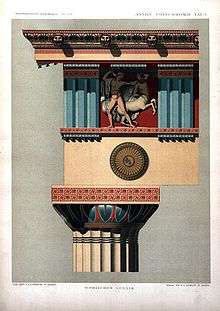
Polychromy: painting on statuary and architecture
Much of the figural or architectural sculpture of ancient Greece was painted colourfully. This aspect of Greek stonework is described as polychrome (from Greek πολυχρωμία, πολύ = many and χρώμα = colour). Due to intensive weathering, polychromy on sculpture and architecture has substantially or totally faded in most cases.
Architecture
Painting was also used to enhance the visual aspects of architecture. Certain parts of the superstructure of Greek temples were habitually painted since the Archaic period. Such architectural polychromy could take the form of bright colours directly applied to the stone (evidenced e.g. on the Parthenon, or of elaborate patterns, frequently architectural members made of terracotta (Archaic examples at Olympia and Delphi). Sometimes, the terracottas also depicted figural scenes, as do the 7th-century BC terracotta metopes from Thermon.
Sculpture
Most Greek sculptures were painted in strong and bright colors. The paint was frequently limited to parts depicting clothing, hair, and so on, with the skin left in the natural color of the stone, but it could also cover sculptures in their totality. The painting of Greek sculpture should not merely be seen as an enhancement of their sculpted form, but has the characteristics of a distinct style of art. For example, the pedimental sculptures from the Temple of Aphaia on Aegina have recently been demonstrated to have been painted with bold and elaborate patterns, depicting, amongst other details, patterned clothing. The polychromy of stone statues was paralleled by the use of different materials to distinguish skin, clothing and other details in chryselephantine sculptures, and by the use of different metals to depict lips, fingernails, etc. on high-quality bronzes like the Riace bronzes.
Vase painting
The most copious evidence of ancient Greek painting survives in the form of vase paintings. These are described in the "pottery" section above. They give at least some sense of the aesthetics of Greek painting. The techniques involved, however, were very different from those used in large-format painting. The same probably applies to the subject matter depicted. It should be noted that strictly speaking, vase painting was a separate skill or art from potting. It should also be kept in mind that vase painting, albeit by far the most conspicuous surviving source on ancient Greek painting, was not held in the highest regard in antiquity, and is never mentioned in Classical literature.
See also
| Wikimedia Commons has media related to Ancient Greek art. |
- Ancient Greek architecture
- Bacchic art
- Black-figure pottery
- Classical architecture
- Culture of Greece
- Hellenistic art
- Parthian art
- List of Ancient Greek temples
- National Archaeological Museum of Athens
- Red-figure pottery
References
- ↑ Whitley, James (2001). The Archaeology of Ancient Greece. Cambridge University Press. p. 286. ISBN 0521627338.
- Greece: From Mycenae to the Parthenon, Henri Stierlin, TASCHEN, 2004
External links
| Wikisource has the text of the 1911 Encyclopædia Britannica article Greek Art. |
| ||||||||||||||||||||||||||||||||||||||||||||||||||||||||||||||||||||||||||||||||||||||||||||||||||||||||||||||||||||||||||||||||||||||||||||||||||||||

